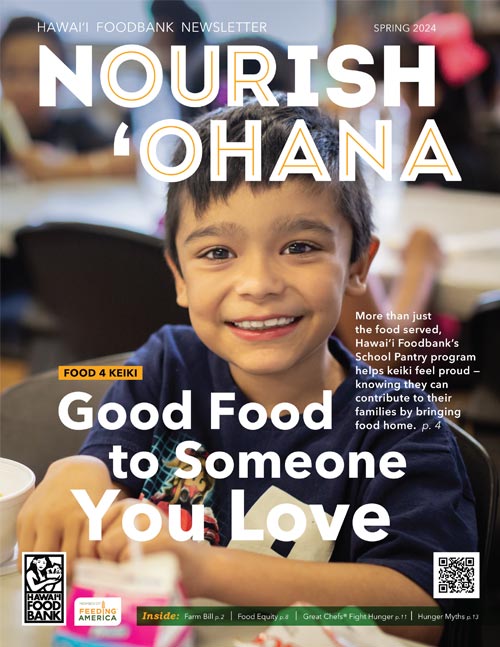What Does the Farm Bill Mean for Hawai‘i?

Amy Miller
Our neighbors facing hunger need decision-makers to prioritize the Farm Bill
Food serves as more than just sustenance; it connects us to our roots, our land and our loved ones. It’s a thread that weaves through our cultures, memories and traditions, and is a beautiful way we share with one another in the warmth of community. Yet, amidst the beauty of the many shared culinary traditions we have here in Hawai‘i, there exists a harsh reality. While food is a source of connection and comfort, too many families in Hawai‘i struggle to put nutritious meals on the table. The simple desire to provide for our loved ones — to ensure our children grow strong and our kūpuna are cared for — is often overshadowed by the challenge of food insecurity.

In Hawai‘i, nearly 160,000 individuals and families rely on Hawai‘i Foodbank for support each month, many of them the most vulnerable members of our community. It’s estimated that 1 in 4 keiki may be going to bed hungry each night. This is why we are committed to creating a future where every member of our extended ‘ohana has access to safe, nutritious food all year long.
The national Farm Bill, which was most recently signed into law in 2018 and extended by President Biden through Sept. 30, is one crucial component in our collective effort to combat food insecurity. It is the largest piece of federal legislation for food and farming, governing many nutrition and agriculture programs. The Farm Bill reauthorization process, which is currently underway, provides an opportunity to strengthen programs like The Emergency Food Assistance Program (TEFAP), the Commodity Supplemental Food Program (CSFP) and the Supplemental Nutrition Assistance Program (SNAP).

Hawai‘i Foodbank and our partners across Hawai‘i’s hunger relief network rely on these programs to fulfill our mission. Here’s a look at how each program supports our local food assistance efforts:
- TEFAP enables food banks like ours to distribute surplus food from U.S. farms and producers to families facing hunger.
- CSFP, more commonly known as the Senior Food Box Program, provides monthly boxes of pantry staples to low-income kūpuna.
- SNAP plays a crucial role in helping families afford groceries, ensuring millions of Americans can put food on the table. In Hawai‘i, SNAP is especially beneficial in helping families stretch their food budgets, as the cost of living here is among the highest in the nation, and food prices have surged by more than 25% over the last few years.
These federal nutrition programs, along with our partners Maui Food Bank and The Food Basket, work in tandem with Hawai‘i Foodbank’s other hunger relief efforts to help ensure everyone in Hawai‘i has equitable access to the food and resources we all need to thrive. However, the efficacy of these programs hinges on the reauthorization of the national Farm Bill. As we stand at the crossroads of opportunity and challenge, we thank our elected leaders, U.S. Senators Hirono and Schatz and Representatives Case and Tokuda, for prioritizing the reauthorization of the Farm Bill. Their support to expand TEFAP funding and ensure the inclusion of culturally important foods in hunger relief programs helps ensure the well-being of our ‘ohana and the resilience of our communities. Food insecurity not only affects physical health and wellness; letting our neighbors go hungry erodes the fabric of our society.
Together, let us reaffirm our commitment to nourishing our ‘ohana and building a future where no one in Hawai‘i goes hungry. Let’s stand united as a community in our pursuit of food security and ensure that every member of our Hawai‘i ‘ohana has access to the sustenance we all deserve.





